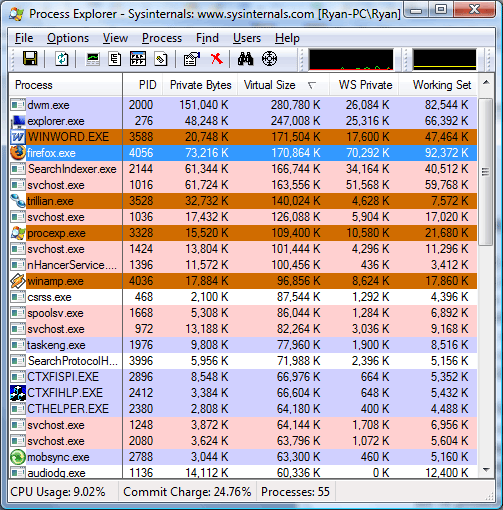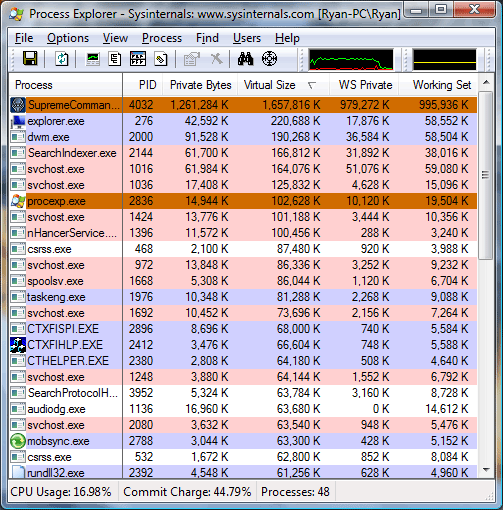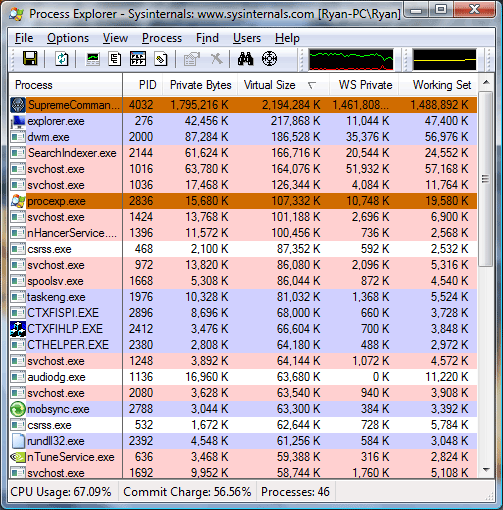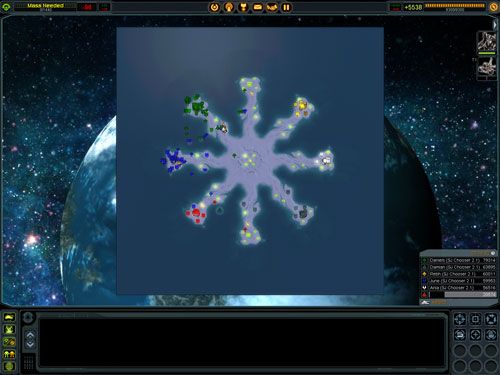A Messy Transition: Practical Problems With 32bit Addressing In Windows
by Ryan Smith on July 12, 2007 12:00 PM EST- Posted in
- Software
As we stated earlier, the inspiration behind this article is Supreme Commander, which was crashing during gameplay due to what we discovered to be was the game exhausting its user space. Without taking extreme and convoluted measures, most applications can do little besides (gracefully) crash when they've exhausted their user space. Server applications, which on the whole tend to be the king of memory hogs in the first place, tend to have some sort of compensation mechanism, but for more generalized applications like games this is not the case.
In this case, Supreme Commander was crashing late in to big games on a system that otherwise is completely stable. No amount of testing could come up with a problem outside of Supreme Commander, and most telltale of all was that it was only a problem with large maps with large number of players with high quality settings; turning anything down made the crashing stop. Although not clearly a memory error it greatly reduces the list of possible problems to a few things. The entire process, we suspect, will be similar for everyone hitting the 2GB barrier: the affected application is crashing under heavy load. Thankfully the problem is possible to debug, albeit with moderate difficulty.
With all of that said, I did not come up with the diagnosis or the solution myself and while the problem in retrospect is quite obvious, at the time I did not even take the 2GB barrier in to consideration. As such, credit for the diagnosis and solution belongs to MadBoris of the Gas Powered Games forums who identified Supreme Commander as hitting the 2GB barrier and publishing a solution for it, which we will cover here.
Getting to the root of the problem requires additional tools beyond what comes with Windows XP or Vista. The task manger, the logical tool for this task, doesn't track the information we need to know. At best, the task manager can list how much data is in the various memory pools altogether, however this is not the metric we're looking for. What we actually need to know is how much of the application's share of the virtual address space has been allocated (the fundamental problem after all is when we run out of unused virtual address space to allocate) which due to a multitude of reasons can be much greater than the amount of memory in use by an application. For finding this we'll need Sysinternals' Process Explorer.

The above screenshot was taken as this paragraph was written, showcasing several different memory values for the running processes. The WS Private (Working Set Private) column lists how much physical memory the application is using, and this is the same column listed by the Windows Task Manager for memory usage. The Private Bytes column is the total amount of memory the application is using. Last but not least however is the Virtual Size column, which finally lists the amount of virtual address space allocated, the metric we're after.
We'll quickly focus on Microsoft Word as an example of the discrepancy between physical memory usage and private size. While Word is only using 17MB of physical memory, its virtual size is 170MB, 10 times the physical memory usage and 9 times the total memory usage. This is more or less a worse case scenario but it also points out just how misleading any memory usage - physical or total - is when trying to diagnose this kind of problem. Applications or games with high memory usage tend to not have nearly as a severe spread, but as we can see it's possible for an application to hit the 2GB barrier well before it needs 2GB of physical memory.
Getting to the meat of things however, the process readout for Supreme Commander basically says everything that needs to be said. In order to prove an exaggerated point, we started a 6 player game with 5 AI units on a maximum size map (81km x 81km) and set the game speed to maximum with maximum quality settings, while patching Supreme Commander and adjusting our system configuration to break the 2GB barrier. This actually isn't very playable for a variety of reasons (we'll overtax the CPU quickly due to all the AI units, slowing the game down dramatically) but represents not only what can happen in bad situations, but also is something that happens even in more manageable situations on smaller maps later in to the game.

Just at the start of the game, our virtual size was already in excess of 1.6GB, dangerously close to the 2GB barrier. 16 minutes in to the game, we have already hit a virtual size of 2.2GB, meaning had we not broken the 2GB barrier the game would have already crashed. At this point our total memory usage (private bytes) is only at 1.7GB, with 1.4GB of that in physical memory, nearly maximizing the RAM usage of our 2GB system. Our spread between memory usage and virtual size is .5GB, showcasing how deceptive memory usage is in identifying 2GB barrier issues.

Finally at 22 minutes in to the game, the game crashes as the virtual size has reached the 2.6GB barrier we have reconfigured this system for. Perhaps the most troubling thing at this point is that Supreme Commander is not aware that it ran out of user space in its virtual address pool, as we are kicked out of the game with a generic error message. Unfortunately Windows Vista reverted to a non-accelerated desktop at this point, preventing us from capturing a screenshot of the exact memory readouts or the error message.











69 Comments
View All Comments
BabyBear - Thursday, July 12, 2007 - link
This also happens with Flight Simulator X by the way.
Over on Phil Taylor's blog he makes mention of it awhile back
http://blogs.msdn.com/ptaylor/archive/2007/06/15/f...">Microsoft's Phil Taylors Blog
There was also some talk that the June 07 DirectX Redist. seemed to 'help' with Out of Memory problems when using the /3gb switch.
joetron2030 - Thursday, July 12, 2007 - link
On "Page 4: A Case Study: Supreme Commander", in the paragraph discussing the first screen shot from Sysinternals' Process Explorer, you refer to the "Virtual Size" column as the "Private Size" column (which doesn't exist in the screen shot).Had me briefly confused.
quanta - Thursday, July 12, 2007 - link
Although Windows 2000/2003/Vista server versions aren't exactly designed for gaming, did anyone tested game titles on these server OS to see if these large address aware titles will use the Physical Address Extension feature?Ryan Smith - Thursday, July 12, 2007 - link
The short answer is no.The longer answer is that due to a combination of chipset support, software support, performance, and driver support, it's not really usable outside of a server environment and shouldn't be used on a consumer system.
brink - Thursday, July 12, 2007 - link
Wouldn't matter, WinXP SP2 uses PAE, why would you want to install it on a server OS? Only 2003 is a server OS of the ones you mentioned, and I think only Windows 2003 Enterprise is the only 32-bit OS that has the ability to use more than 4GB of memory (8GB seems to be the limit for what modules/mobos are available right now)TA152H - Thursday, July 12, 2007 - link
I'm just reading the remarks about the 386 pushing the memory from 1 MB, to 4 GB. It's patently untrue, unless you think the 386 succeeded the 8086, and not the 286. The 286 had 24 bit addressing (in 64K segments) for 16 MB of memory. This is not only what OS/2 used, but extended memory as well. So, it's not academic.Ryan Smith - Thursday, July 12, 2007 - link
Just hearing the words "segmented memory" gives me flashbacks - and they're not the good kind. For this article we're talking strictly about flat addressing since I could write a small book on just segmented addressing, but I've updated the article to make this clear.TA152H - Thursday, July 12, 2007 - link
Either way, you're using the wrong values. Even on the 8086 the memory was segmented. Actually, so was the 386, but it could handle segments up to 4 GB, so it wasn't important. So, using 1 MB and saying you're not referring to segmentation is inaccurate; that is segmented memory.Segmentation was not a bad thing, particularly back then. It saved memory space, and back in 1978 that was a big thing. Addresses were given in 16 bits, you didn't have to specify the rest, and the net result was you had shorter code. You would have to change the registers to point to the next segment from time to time, but overall it saved a lot of memory. You also could protect apps from each other, but that wasn't really used.
I was an OS/2 developer, and it was a pain sometimes for sure. By the time the 286 came out, which I think was the best processor Intel ever made considering the timing, and the incredible capabilities it had over it's predecessor (the 8086, not the 80186 which was made in parallel with the 286), the extra memory saving was not worth the nuisance of having to deal with, at most, 64K segments. But it really wasn't possible for Intel to do it any other way, as I'll explain below.
Motorola even added some external memory management unit that added segmentation, which today seems strange. It's widely viewed now as just a bad thing, but back then, it wasn't. Motorola really had a choice though, since the 68K was part 32-bit, and part 16-bit, and part 24-bit (addressing). Although the 286 was a more powerful processor than the 68000, it was pure 16-bit, except for the oddity of the 24-bit addressing. Consequently, allowing flat 24-bit addressing would not have been feasible. So, they dealt with it by just adding more segments. Considering the absolutely incredible improvement in this processor in just about every way, it was not such a bad tradeoff.
BitJunkie - Friday, July 13, 2007 - link
Hiya Bill.jay401 - Thursday, July 12, 2007 - link
Just FYI, SupCom has already exhibited this problem and crashes once it breaks the 2GB barrier, which can happen easily in longer games with a high unit limit.This is mostly due to the poor efficiency in their code and models, something GPG (the developer, Gas Powered Games) reported could not easily be fixed in a patch because they basically have to re-render every unit in the game so they take up less memory. Due to this, it's likely to remain unfixed until the expansion pack (now a standalone game) Forged Alliance comes out in November, if it is fixed at all
One forum member developed a way to increase the addressable memory to around 3GB on 32bit WinXP and Vista, so if you're running 4GB, this provides a sort of band-aid solution in the meantime.